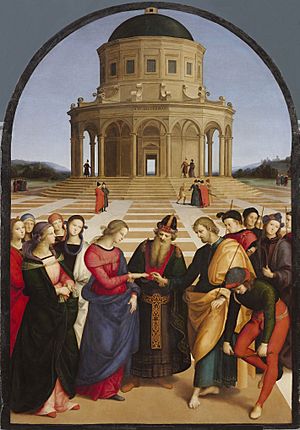Italian Renaissance art facts for kids

Italian Renaissance art is a special way of making paintings and sculptures. It started in the late 1200s with artists like Giotto and Nicola Pisano. This art style became very popular in Italy from about 1400 to 1600. Many famous artists, like Leonardo da Vinci, used and improved this style.
The city of Florence is known as the birthplace of the Renaissance and its amazing art.
Italian Renaissance painting is often divided into four main time periods:
- Proto-Renaissance (1300–1400): This period began with Giotto. Other artists included Taddeo Gaddi and Nicola Pisano.
- Early Renaissance (1400–1475): Important artists were Masaccio, Fra Angelico, Uccello, Piero della Francesca, Verrocchio, Ghiberti, and Donatello.
- High Renaissance (1475–1525): This was the time of Leonardo da Vinci, Raphael, Titian, and Michelangelo. Michelangelo was famous for both sculptures and paintings.
- Mannerism (1525–1600): Artists from this period include Andrea del Sarto, Pontormo, Tintoretto, Giambologna, and Cellini.
The Renaissance Begins



The Renaissance was a time of great change in Europe. People started to look back at the ideas and art of ancient Greece and Rome. This led to new ways of thinking about art, science, and life. Artists began to study the human body and how light works. They also learned how to create depth in their paintings using perspective. This made their art look much more realistic.
The Medici Family and Art
The Medici family was very powerful and rich in Florence. Cosimo de' Medici was a smart and religious man. He wanted to do great things for his city. He became a big supporter of art and learning. He paid many artists to create beautiful paintings and sculptures.
Cosimo also collected many books. He gave them to the Friary of St Mark to create a library. This allowed many people to read and learn. After Cosimo, his sons and grandsons, like Lorenzo, continued to support artists. They even brought together philosophers, poets, and artists in a group called the "Medici Academy." This support helped Renaissance art to grow and become famous.
Other pages
- Renaissance
- Renaissance architecture
- Mannerism
- List of Renaissance artists
- Giorgio Vasari
- Duecento
- Trecento
- Quattrocento
- Cinquecento
Images for kids
-
Sandro Botticelli, Primavera, showing a Classical allegory for a private patron
-
Duccio di Buoninsegna: Madonna and Child (c. 1280) at the National Gallery, London, is mainly Italo-Byzantine in style.
-
Giotto: The Lamentation, c. 1305, Scrovegni Chapel, foreshadows the Renaissance.
-
Simone Martini: The Annunciation, 1333, Uffizi, is International Gothic in style.
-
St. Jerome in His Study, c. 1475. National Gallery, London
-
Leonardo da Vinci: The Last Supper
-
Michelangelo: The Creation of Adam
-
Raphael: The School of Athens, commissioned by Pope Julius II to decorate a suite now known as the Raphael Rooms in the Vatican
-
Giovanni Bellini, The San Zaccaria Altarpiece
-
Correggio: Assumption of the Virgin
See also
 In Spanish: Pintura renacentista de Italia para niños
In Spanish: Pintura renacentista de Italia para niños
















